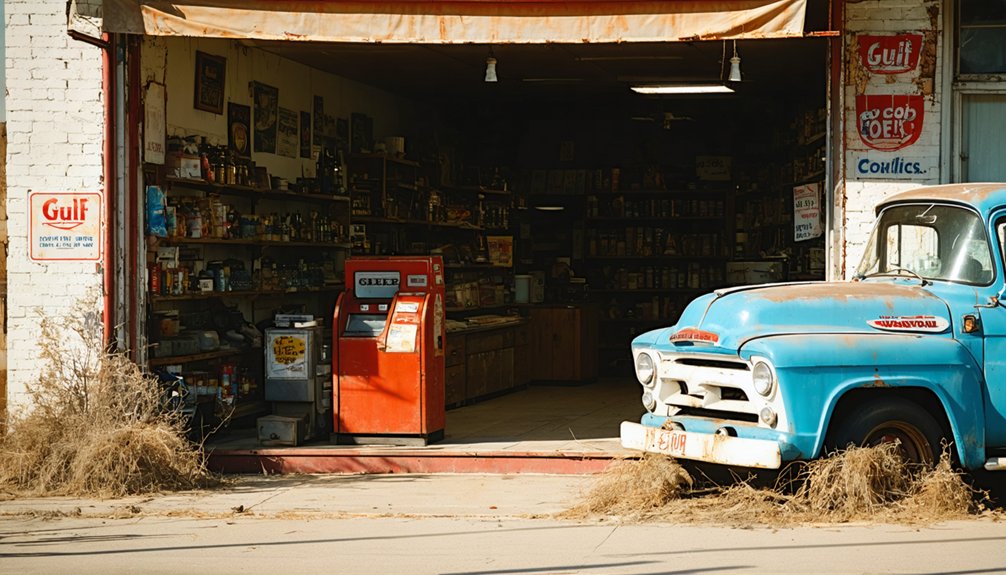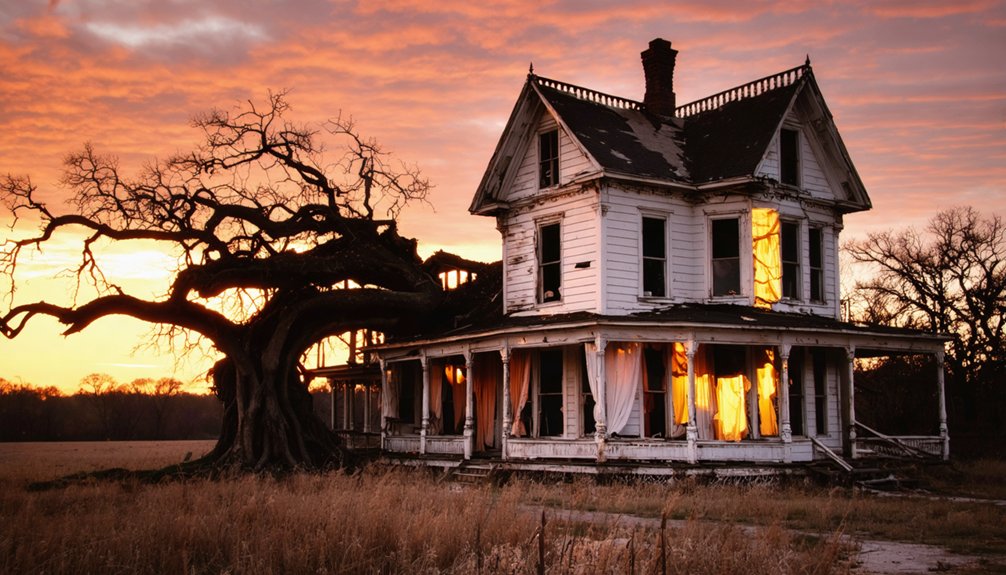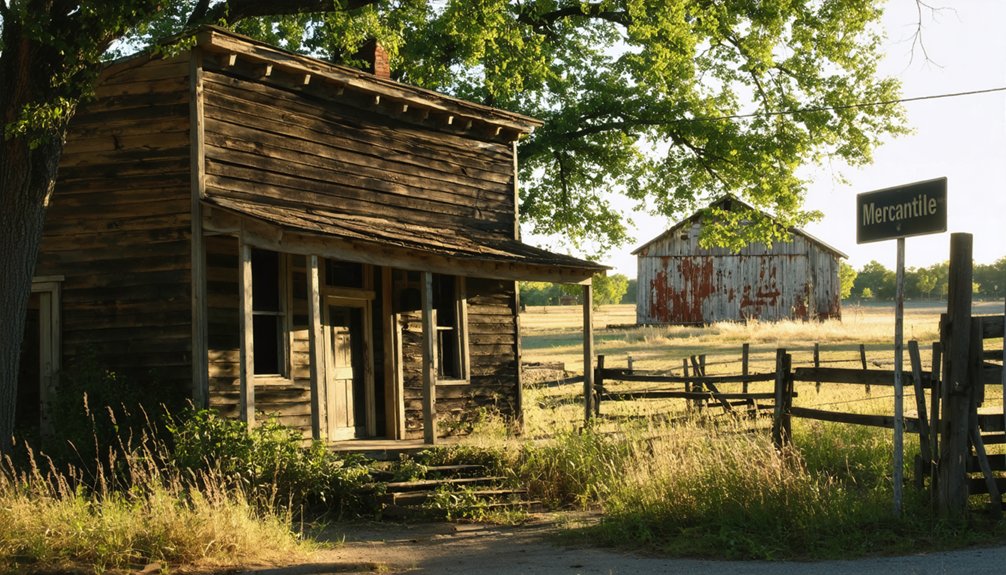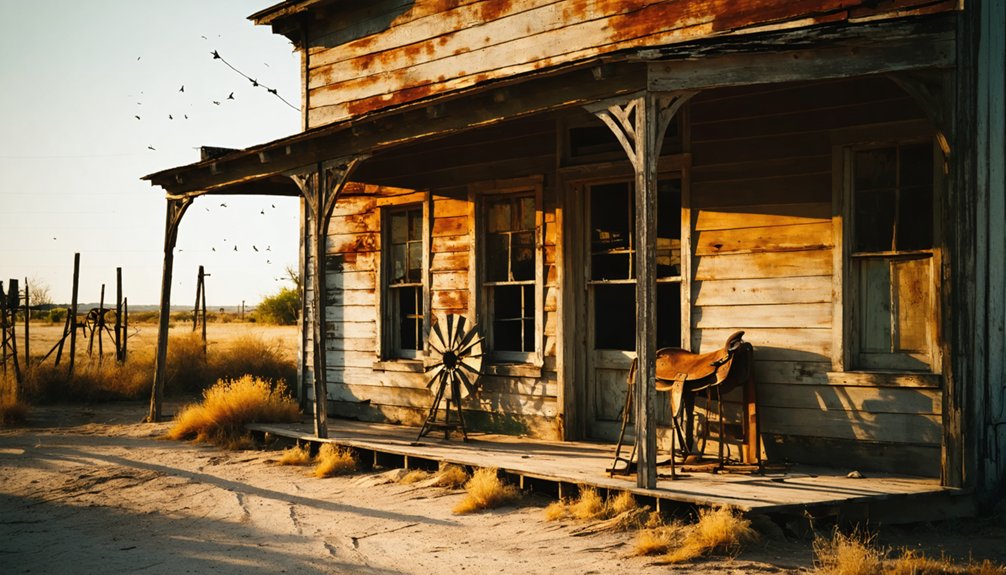You’ll find Vieja Springs, a West Texas ghost town, at a historic crossroads where Native Americans, Spanish settlers, and American pioneers once thrived. The town flourished in the late 1800s as a bustling railroad junction, with the San Antonio & Gulf Railroad fueling its growth through freight and passenger service. Though its buildings now stand in ruins, the site’s strategic location near protective rim rock cliffs and natural springs holds countless stories of frontier life, railroad commerce, and Pancho Villa’s infamous raids.
Key Takeaways
- Vieja Springs became a ghost town after railroad companies rerouted tracks, causing economic decline and mass exodus of residents.
- The town’s strategic location at Vieja Pass and its reliable water source made it crucial for early Texas settlement and transportation.
- Fort Holland’s military presence from 1915-1920 protected the area from Pancho Villa’s bandits before the town’s abandonment.
- Adobe ruins, stone foundations, and commercial building remnants showcase the town’s frontier architecture and gradual decay.
- The Rock House and surrounding areas are known for paranormal activity, with reports of mysterious figures and unexplained sounds.
The Birth of a Frontier Settlement
While indigenous peoples had inhabited the region for millennia, Vieja Springs’ formal settlement began during the Spanish colonial period of the early 1700s.
You’ll find that frontier life emerged at the confluence of two major rivers, where the fertile floodplains had long supported Native communities like the Jornada Mogollon. Similar to the Villa de Bexar settlement, the early community provided housing for military families. The settlement patterns followed Spain’s strategic approach of establishing civilian communities near missions and presidios to maintain territorial control.
The protected river valley offered both opportunities and challenges. Though floods regularly reshaped the terrain, creating rich bottomlands ideal for agriculture, they’ve also eroded much of the archaeological evidence of early occupation.
Nature’s rhythms shaped life in the valley – floods that nourished farmland also washed away traces of those who came before.
You’ll notice how Spanish settlers, like their indigenous predecessors, adapted to this dynamic landscape by building on higher river terraces while farming the floodplains below. New settlers constructed dogtrot cabins as their first form of shelter in the wilderness.
Railroad’s Golden Age and Local Growth
When you visit Vieja Springs today, it’s hard to imagine the bustling railroad junction it became after the San Antonio & Gulf’s expansion in the late 1890s connected the town to broader trade networks.
You’d have seen a steady stream of freight cars hauling salt, coal, cotton, and sand through the junction, with the railroad reporting significant growth in both passenger earnings ($15,000) and freight income ($46,000) by 1903.
The town’s strategic position along the expanding rail network attracted businesses that relied on efficient freight transport, transforming this frontier settlement into a promising commercial hub during the railroad’s golden age. Just 15 miles from the town’s historic rail junction, modern-day visitors can explore more transportation history at 11731 Wetmore Road. Similar to other Texas towns like Mexia, the arrival of the Houston & Texas Central Railway in the area spurred rapid population growth and development.
Railroad Junction Development
During the late 19th century’s railroad Golden Age, Vieja Springs’ development hinged on its strategic position near essential rail junctions where multiple lines intersected.
The railroad significance became evident as multiple companies vied for control of these pivotal connection points, sparking intense junction competition that would shape the region’s future. The East Line & RR reached the region in 1877, establishing one of the earliest rail connections. Local politicians worked tirelessly to ensure strategic routing of rail lines would benefit their communities.
You’d have witnessed the town’s transformation as rail networks, including the Texas & St. Louis Railway, expanded through eastern Texas.
These connections created crucial links to Arkansas and Missouri by the 1880s. The junction’s presence attracted businesses and settlers, boosting land values and establishing Vieja Springs as an accessible hub.
As rail companies competed for dominance, they improved their services and infrastructure, cementing the town’s position in the growing regional economy.
Freight Transport Boom
Three major developments transformed Vieja Springs into a freight powerhouse in the early 1900s. As railroad companies expanded their reach, you’d have witnessed a remarkable freight evolution that revolutionized local commerce and regional connectivity.
- The San Antonio, Uvalde & Gulf Railroad’s 41-mile extension created essential links to agricultural markets.
- Competition between towns for rail service led to strategic infrastructure investments.
- New freight depots, like the two-story 1913 facility, established control points for managing cargo flow.
The economic impact rippled through the region as farmers and ranchers gained direct access to distant markets. Today, you can explore this railroad heritage at 11731 Wetmore Road in San Antonio.
You could’ve seen how the rail freight boom diversified the local economy, turning smaller settlements into thriving centers of commerce. The cost savings were substantial, as transportation expenses dropped from twenty cents per ton mile by wagon to just pennies by rail.
Without the constraints of isolated markets, producers finally had the freedom to expand their reach and compete on a national scale.
Daily Life in Early Vieja Springs
You’d find daily life in early Vieja Springs centered around the ranch headquarters, where residents gathered for social events after long days of cattle work and household duties.
Local commerce revolved around essential trading of livestock, supplies, and services between neighboring ranches, with the springs serving as a natural meeting point for travelers and traders. Many residents purposefully avoided cutting down nearby trees due to the Akokisa tribe’s curse, which was believed to bring misfortune to the land. Like many towns that would later face economic changes, the community relied heavily on passing trade routes to sustain local businesses.
The isolation meant families had to be largely self-sufficient, maintaining vegetable gardens, preserving food, and creating their own entertainment through storytelling, music, and community gatherings at the Rock House.
Social Gatherings and Entertainment
While historical records of daily entertainment in Vieja Springs remain sparse, the settlement’s social life likely centered around key gathering spots like the natural springs and nearby ranch properties.
The area’s social fabric was woven through community events and military interactions, as soldiers from Fort Holland and Dios E Ocho Creek Camp mingled with locals.
You’d have found these common entertainment options in early Vieja Springs:
- Informal gatherings at ranch headquarters featuring storytelling, music, and impromptu dances
- Card games and social activities at multipurpose venues like general stores and saloons
- Military-civilian celebrations and dances when troops were stationed nearby
The springs themselves served as a natural meeting point, where travelers and residents would exchange news and stories while collecting water in the harsh desert environment.
Household Chores and Duties
Life in early Vieja Springs demanded a rigorous daily routine centered around the settlement’s precious water source. You’d start your day fetching water from the spring for cooking, washing, and livestock care, carefully rationing this essential resource through all seasons.
Your household routines revolved around time-intensive food preparation, including grinding grains, processing vegetables, and preserving meats through smoking or drying.
Daily responsibilities extended to laborious laundry tasks using washboards and homemade soaps, while mending worn clothing became a constant necessity.
You’d tend to livestock, milking dairy animals and collecting eggs, while maintaining their pens and shelters.
Home maintenance never ended – from sweeping dirt floors to patching roofs and repairing walls to protect against harsh weather.
Every chore depended on careful planning and community cooperation to sustain life in this challenging environment.
Trading and Local Commerce
Trading in early Vieja Springs centered around bustling general stores and trading posts that served as essential commercial hubs for the community.
You’d find these establishments stocked with everything from farming tools and metal goods to canned foods and tobacco products. The trading dynamics often involved both cash transactions and barter systems, as currency could be scarce in this remote settlement.
- You could purchase branded products like Coca-Cola and specialty cigars, showing the town’s connection to wider commercial networks.
- If you worked for a company store, you’d likely use scrip instead of cash, limiting your purchasing freedom.
- You’d need to carefully safeguard your money, often keeping “heavy money bags” under your pillow at night.
Local commerce thrived on the exchange of essential goods and services, reflecting the self-reliant spirit of frontier life.
Economic Forces Behind the Decline

As railroad companies began rerouting tracks and transportation networks shifted in the mid-20th century, Vieja Springs faced mounting economic pressures that would ultimately lead to its demise.
You’ll find this story mirrors countless other Texas towns where transportation changes triggered devastating economic decline. The town’s isolation from new rail routes crippled local commerce, causing businesses to shutter and residents to seek opportunities elsewhere.
Population shifts accelerated as crucial services disappeared – the post office closed, followed by the general store and school. Without these essential community anchors, families couldn’t justify staying.
Like many single-industry towns of its era, Vieja Springs couldn’t diversify its economic base beyond its original trading post roots, making it especially vulnerable when transportation patterns changed. Each departing resident further weakened the town’s chances of survival.
Architectural Legacy and Remaining Structures
The architectural remains of Vieja Springs tell a story of resourceful frontier construction and gradual decay. You’ll find scattered adobe ruins and stone foundations that showcase the town’s architectural significance, with structures built from locally sourced materials reflecting traditional West Texas building techniques.
- Original building footprints reveal modest single-room and few-room designs, while surviving commercial structures retain shells of general stores and post offices.
- Adobe walls and masonry work display the craftsmanship of immigrant laborers, particularly in the skilled brickwork of industrial buildings.
- Preservation challenges include severe environmental degradation, with many structures reduced to foundational remnants or doorway remains.
Today’s adaptive reuse efforts balance historical integrity with modern functionality, as some ruins find new life as guesthouses or artist studios while maintaining their authentic frontier character.
Tales From the Abandoned Streets

You’ll hear tales of mysterious figures peering from the Rock House windows at Vieja Springs, where Pancho Villa’s bandits once took refuge during their raids in the early 1900s.
As you walk the abandoned streets near midnight, locals say you might encounter unexplained sounds reminiscent of military patrols that once tracked outlaws through these grounds.
Standing at the old railroad crossing, you’ll find yourself at the nexus of ghostly legends that interweave the area’s violent past with reports of spectral activity, particularly around the springs that drew both outlaws and lawmen to this remote location.
Whispers From Empty Windows
Standing silently among the windswept desert mountains of Presidio County, Vieja Springs‘ abandoned structures whisper tales of a tumultuous past through their empty windows and crumbling walls.
The ghostly encounters reported near Fort Holland and the Rock House echo the violent history of Pancho Villa’s bandits, military conflicts, and frontier justice.
- The partially standing Rock House, once Villa’s headquarters, draws paranormal investigators who claim to witness spectral figures moving through its deteriorating rooms.
- Fort Holland’s ruins stand as silent sentinels, where historical hauntings are said to manifest as residual energy from military-bandit confrontations.
- The ancient springs, sacred to Native Americans and essential to early settlers, remain a focal point for unexplained phenomena, blending centuries of overlapping cultural narratives.
Midnight At Railroad Crossing
Midnight whispers carry far across Vieja Springs’ abandoned rail crossing, where ghostly echoes of steam whistles still pierce the darkness.
You’ll find yourself standing where the Texas and Pacific once crossed paths with the Texas Short Line, each train required to halt before proceeding through the gates. Local tales speak of midnight train sightings, with phantom lights dancing along rusty tracks that once carried salt and coal from nearby mines.
The crossing’s abandonment mirrors countless others across Texas, where dwindling resources and shifting economies forced railways to pull up stakes.
Yet on moonless nights, you might catch the distant rumble of phantom railroad crossings coming alive – a haunting reminder of when two iron horses would meet here, their steam-powered hearts beating in the dark.
Natural Landmarks and Geographic Features
Located in the heart of Texas’s diverse terrain, Vieja Springs features a complex network of natural springs that emerge from the region’s distinctive karst and limestone geology.
These spring ecosystems create subtropical microenvironments that stand in stark contrast to the surrounding arid landscape, supporting unique flora and fauna in this change zone between the Hill Country and desert regions.
- Natural pools and waterfalls form around limestone cliffs, where historic pictographs reveal the area’s cultural significance.
- The karst landscapes create an intricate underground water system that feeds surface streams and floodplains.
- Spring-fed pools provide essential water sources that have historically shaped human settlement patterns and continue to influence local biodiversity.
You’ll find steep trails and rugged terrain surrounding these critical water features, offering both challenge and reward for those seeking to explore these natural landmarks.
Preservation Efforts and Current Status

While these natural landmarks have shaped the region’s history, the preservation status of Vieja Springs remains largely unofficial and community-driven.
You’ll find the site’s protection primarily relies on local stewardship, with Vieja Ranch headquarters and historical groups serving as informal custodians of its cultural heritage.
Two key structures still stand: Fort Holland’s ruins and the Rock House, though they face significant preservation challenges.
The remote location, accessible only by 4WD vehicles, limits visitor traffic and preservation efforts.
There’s no formal tourism infrastructure or protective legislation in place, leaving the site vulnerable to vandalism and natural erosion.
Without official recognition or dedicated funding, the ghost town’s future depends entirely on community involvement and private initiatives to maintain what remains of this historic water source and Pancho Villa’s former refuge.
Local Legends and Folklore
Deep in the heart of Vieja Springs, supernatural tales and ghostly legends have woven themselves into the fabric of local culture.
You’ll find stories of supernatural encounters near Fort Holland’s ruins, where spectral riders appear at dusk and eerie sounds echo through the remote landscape. The area’s connection to Native American history has spawned tales of ancestral spirits and ancient curses protecting sacred grounds.
- Phantom whispers and unexplained footsteps often greet visitors during quiet nights at the springs.
- Local lore tells of ghostly children, linked to tragic epidemics that once swept through similar settlements.
- Mysterious figures, including women in white dresses and soldiers, are frequently spotted near the rock formations.
The harsh climate and isolation of Vieja Springs continue to fuel these haunting tales, preserving the area’s mystique for generations.
Historical Significance in Texas Settlement Patterns
Beyond the supernatural tales that haunt its memory, Vieja Springs played a defining role in shaping Texas settlement patterns during the state’s frontier era. As the only reliable water source for miles around, you’ll find its strategic position determined where people could survive in this unforgiving landscape.
The springs’ location in Vieja Pass created an essential lifeline between Valentine and the Rio Grande, while its protective rim rock cliffs offered natural defense against threats.
Military influence became particularly pronounced during the 1915-1920s, when Fort Holland and Dios E Ocho Creek Camp used the springs as a base to counter Pancho Villa’s bandits.
You’ll see how this military presence, combined with the springs’ critical water supply, reinforced settlement patterns along defensible water sources throughout West Texas, making Vieja Springs an indispensable hub for regional trade and ranching operations.
Frequently Asked Questions
Are Any Original Families From Vieja Springs Still Living in Nearby Communities?
You’ll find local descendants scattered through Big Spring, Midland, and Pecos, where family histories are preserved by historical societies, though exact connections to original Vieja Springs settlers remain challenging to verify.
What Indigenous Tribes Inhabited the Area Before Vieja Springs Was Established?
While you’d expect many tribes to have inhabited this rich land, the Apache were the primary Native American tribe documented here, though archaeological evidence suggests thousands of years of earlier cultural heritage.
Were There Any Notable Crimes or Lawmen Associated With Vieja Springs?
You’ll find a rich crime history centered around Pancho Villa’s bandits who used the area as a hideout, while law enforcement from Fort Holland actively pursued them between 1915-1920s.
Did Vieja Springs Have Connections to Cattle Drives or Major Ranches?
You’ll find historical significance in the area’s cattle ranching connections, as nearby springs served ranchers during drives, though specific records don’t confirm major ranch ownership or direct trail links.
What Natural Disasters or Epidemics Impacted the Town’s Population?
You won’t find documented disease outbreaks or flood events impacting this town’s population. Historical records show social and military factors, not natural disasters, shaped the area’s demographic changes.
References
- https://www.county.org/county-magazine-articles/summer-2025/ghost-towns
- https://southwritlarge.com/articles/the-curse-of-old-town-spring/
- https://www.hipcamp.com/journal/camping/texas-ghost-towns/
- https://www.youtube.com/watch?v=9HbEbKnh3Ds
- https://texashighways.com/travel-news/four-texas-ghost-towns/
- https://www.youtube.com/watch?v=phjUE19A8HM
- https://en.wikipedia.org/wiki/List_of_ghost_towns_in_Texas
- https://www.texasescapes.com/TexasHillCountryTowns/Roca-Springs-Texas.htm
- https://www.ghosttowns.com/states/tx/viejasprings.html
- https://www.uiw.edu/sanantonio/FirstCivilSettlementinTexas.html



